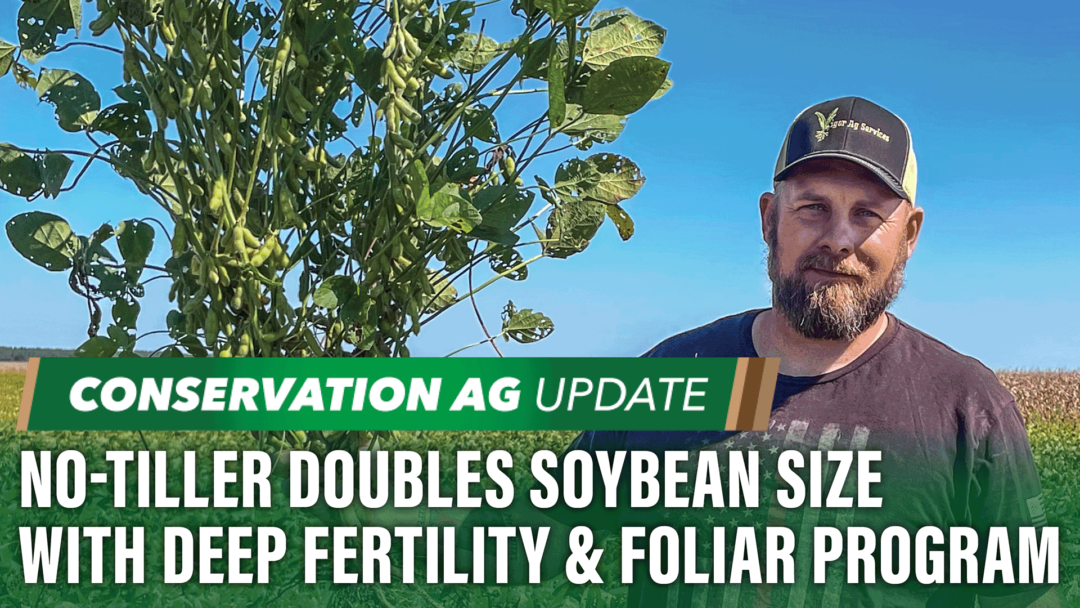On this episode of Conservation Ag Update, brought to you by CultivAce, Hickory, N.C., record-breaking no-tiller Russell Hedrick shares how he was able to decrease his soybean seeds per pound from 2,800 to under 1,400.
In the Farmer Feature segment, Hopkinton, Iowa, no-tiller Ryan Gibbs gives a crash course on how to use a refractometer to measure brix levels in corn and soybeans.
Also in the episode, assistant editor Mackane Vogel introduces us to Norm, the AI agronomist, a John Deere representative explains why more companies are expanding their presence in the retrofit market, and Beck’s Practical Farm Research (PFR) shares results from a broadcasting vs. banding study.
This episode of Conservation Ag Update is brought to you by CultivAce.
CultivAce is a West Coast manufacturer and distributor of a comprehensive line of foliar and starter fertilizers. CultivAce offers innovative solutions that drive agricultural crop yields and cultivate profitableoutcomes.
With a relentless focus on delivering the highest quality foliar and starter fertilizers, we are committed to empowering growers with the tools they need to achieve remarkable results. CultivAce is built on two fundamental principles: products must be the highest quality, and they must make the grower money. If a product doesn’t meet these standards, CultivAce doesn’t manufacture it.
For more information go to CultivAcegrowth.com.
TRANSCRIPT
Jump to a section or scroll for the full episode...
- Russell Hedrick Increases Soybean Size with Deep-Injection Fertility
- Farmer Feature: Ryan Gibbs, Hopkinton, Iowa
- Cover Crop Connection: Introducing Norm, the AI Agronomist
- Ahead of the Curve: OEMs Embrace Retrofit Market
- Video of the Week: Banding vs. Broadcasting
Russell Hedrick Increases Soybean Size with Deep-Injection Fertility
Welcome to CAU. Let’s kick things off in Hickory, N.C., where no-tiller Russell Hedrick had a new state soybean record in his crosshairs, until not one, but two tornadoes hit his farm on the same day in September. He expected 160-bushel yields before that happened. But all things considered, everything turned out pretty well.
Russell ended up with around 90 bushels per acre in his high-yielding plot. He came up a little short of his state record yield of 117 in 2021. But this year he tried something new.
He used this deep-banding fertilizer bar with Yetter 2996 20-inch coulters to inject 11-37-0, KTS, micronutrients and algae 4-6 inches deep ahead of his planter. Hedrick says this helps with late-season fertility uptake — placing the nutrients in the soil where there’s more moisture availability in the summer.
Check out the results. His soybeans weighed in at 2,841 seeds per pound in the fields under his normal fertilizer program. That number dropped to 1,736 seeds per pound in the fields with his deep-injection fertility program. And even lower to under 1,400 seeds per pound in the deep-injection field that was also under a foliar fertilizer program. Bottom line — lower seeds per pound means bigger seeds and bigger yields.
“1,100 to 1,200 seeds per pound is a pretty huge difference. We started working with a program called Foliar Rx. Essentially, it’s a way for us to pull tissue samples on our crops, and it actually gives us recommendations on how many ounces of product that we need to apply, rather it’s boron, manganese, zinc, phosphorous. Any element that we’re seeing on the tissue samples, it gives us a recommendation in ounces of product that we need to spray to bring that plant back into balance because being short on nutrients can be just as detrimental as being too high in nutrients. Keeping that plant balanced with that foliar program got our seed size down to 1,359 seeds per pound. Those soybeans look like pinto beans.”
Hedrick says the Foliar Rx program cost him around 50 cents per acre.
Farmer Feature: Ryan Gibbs, Hopkinton, Iowa
34-year-old Ryan Gibbs steps into the Farmer Feature spotlight this week. The Iowa Farm Bureau presented the Hopkinton, Iowa no-tiller with the Young Farmer Leadership Award, which honors farmers under the age of 35 for their leadership in the community.
That leadership and passion for conservation farming was on full display when our managing editor Michaela Paukner paid him a visit over the summer. Here he is, with his son, Kendrick, taking Brix readings in corn around V3 with a refractometer. He takes a few leaves, smashes them with a garlic press, and transfers the sap to the refractometer. The brix reading shows how much sugar content is in the plant. Low brix readings indicate a higher risk of an insect attack or fungal attack. Kendrick, what’s the verdict?
“What number is it? How many?”
“10”
“10 – God, I hope so! Let’s find out. I would say it’s about 4. It’s a hazy line, which is telling us that we’re getting adequate calcium. We are at a brix reading of 4. It’s 11 o’clock, we probably should’ve done this a little earlier in the morning.”
“Ideally, we want to be over 10. When a plant gets up to 13, an insect cannot consume it, because it doesn’t have a pancreas. That means the sugar level is so high in it, that an insect cannot process those sugars, and they’ll die if they try to eat the plant.”
Gibbs bought that refractometer for about $25 on Amazon.
Norm the AI Agronomist — Quick Cover Crop Help
Charles Baron with Farmers Business Network told me all about the organization’s latest innovation, Norm the AI Agronomist. Norm is an online tool that uses artificial intelligence to scan the internet and agronomic research to answer questions about agronomy, farm management practices and more. Baron says that while still in its beta stage, many have already experimented with asking Norm questions about no-till and cover crops and how to best implement those types of conservation ag practices in different climates.
“Norm is going to actually give you responses and help you answer questions, and you can have a conversation with it. So, if it doesn’t answer your question right away, you ask it a follow up question and it will keep learning about you and keep learning about your question as you’re asking it to give you the best response. It’s really pretty fun. It can answer questions about all kinds of stuff, everything from equipment to crop rotation and tillage and agronomic practices. We are training Norm right now on chemical intelligence and things like labels, tank mix data, licensing and pest targeting, so that Norm can be used to support farmers when they are buying products, using products and making agronomic decisions in the field. It is, of course, not an agronomist. It is a technology system, right. So you still need to have the kind of agronomic support or veterinary support. But it can help growers answer very basic or common questions and help them march further along the way in being more autonomous and more independent. One of the common questions people ask about no-till, is how do I implement no-till or what should I consider to implement no-till. And Norm will help with that decision-making process, it will help talk through what are the common steps either to introduce no-till on the farm or other management practices that you’d want to consider.”
And if you’d like to try asking Norm your own cover crop questions, just go to FBN.com/norm and create a free account.
Ahead of the Curve: OEMs Embrace Retrofit Market
During a recent editorial meeting, our boss Frank Lessiter shared an interesting article from the Wall Street Journal, talking about how OEMs like AGCO, Deere and CNH are expanding their presence in the retrofit market, giving them more access to the 93% of global farmers who aren’t replacing their old equipment in any given year.
I saw an example of this retrofit mindset from Deere at the Farm Progress Show. The company debuted its new See and Spray Premium package, which can be retrofitted to any sprayer model year 2018 or newer, as opposed to See and Spray Ultimate that can only be purchased from the factory. In their eyes, the retrofit option is easier, faster and will drive more technology to the farm.
“If you’re looking at you just got a 2-year-old sprayer or 4-year-old sprayer, and you’re not ready to upgrade to a brand new one, or you just got that sprayer and you want to get the latest and greatest technology, you can do that with See and Spray Premium. You don’t have to go buy a whole new sprayer. You can get that as a precision upgrade on your sprayer today. So, if you’re looking to get little incremental value on your sprayer and take advantage of this technology, what we’re trying to do is not make you fully commit to a totally different sprayer. You can get that, order it, get it installed on your sprayer today, and get this awesome technology where you can go in the field, spray just weeds, cut down on your costs and look at better yields.”
Video of the Week: Banding vs. Broadcasting
Our Video/Photo of the Week features an update on a broadcast vs. banded fertilizer study from Beck’s Practical Farm Research. Brandon Somers, break it down for us.
“We have two different studies that we work with for our nutrient management study. One being a fall vs. spring applied. So, we put in our fall strips today, we’ll come back this spring, right before we plant and put in the spring apply. Under those we put 300 pounds of a 50/50 blend of MAP and potash directly underneath the row. Then in our nutrient management study, we look at — can we cut rates by the efficiency we pick up using this banding bar behind me? We look at a 100% rate, a 75%, 50% and 25%. We also look at conventional and no-till. When we do that (conventional and no-till), we spread the fertilizer with the air delivery system on the back. We use the same unit — it’s just a matter of where we send the fertilizer via different hoses.”
 |
Here’s the results from 2022. Strip-till banding with a 25% application rate had the highest ROI at over $47 per acre. Strip-till banding at 100% had the highest yield at 217 bushels per acre. The 3-year study concludes that although additional data is needed, there’s been a fairly consistent trend favoring strip-till banding over no-till broadcasting.
The second part of the study, comparing fall strip-till to spring strip-till, showed a 4.1-bushel advantage to banding P and K with a shank in the spring instead of the fall. More details on No-TillFarmer.com.
Have an interesting photo or video from your farm? Or a story you’d like us to feature on the broadcast? Send me an email at Nnewman@lesspub.com.
And that will wrap things up this edition of Conservation Ag Update. Until next time, for more stories visit no-tillfarmer.com, striptillfarmer.com and covercropstrategies.com. Thanks for stopping by. Have a great day!









